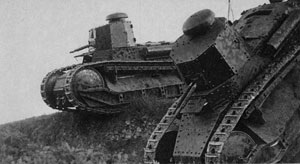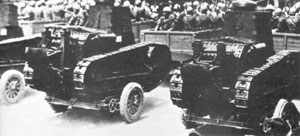| Iron Coffin,
Mark One
By Mike Bennighof, Ph.D.
November 2014
The Royal Italian Army entered the Second
World War with many modern ideas about the
employment of tanks, but few modern vehicles
with which to apply these concepts. As we’ve
seen in a
previous installment, fascist melding
of government and business gave Fiat-Ansaldo
a monopoly on Italian tank construction and
little incentive to provide better vehicles.
Italy’s first production tank, the Fiat 3000, was still
in use in 1940 despite a design dating to
the First World War. An improved version of
the widely-used French Renault FT17, the Fiat
machine was very slow and not armored against
modern anti-tank weapons. When ordered in
1918, the tank was quite modern and the French
provided 100 FT-17 machines to speed crew
training. The Italian Army planned widepsread
use of tanks, and ordered 1,400 of them from
Fiat, with delivery to begin in May 1919.
Production slowed with the war’s end
in late 1918, and the first machines arrived
in 1921. This model had two 6.5mm machine
guns, and a slightly better speed than the
Renault original.

A
pair of Fiat 3000 tanks on manuevers.
In 1926 a tank detachment took a number of
Fiat tanks to Libya for use against the Senussi
tribesmen fighting the Italian army deep in
the desert. The tanks took part in several
actions, but afterwards were shipped back
to Italy. Italy’s first experience of
armored warfare was not particularly successful.
The tankers wanted a more powerful armament,
and in 1929, eight years after the army first
demanded a better vehicle, Fiat finally tested
a 3000 with a 37mm gun in place of the machine
guns. (Here the fascist system was showing
its efficiencies; Ansaldo’s president,
Ugo Cavallero, had been de facto Minister
of War before going to the boardroom and would
become Chief of the General Staff after returning
to uniform.) This improved version went into
production in 1930 as the 3000B; it also sported
a better suspension and more powerful engine
— but due to poor gearing the tank’s
speed actually dropped (Cavallero faced charges
of selling the army poor material but used
his connection to Mussolini to avoid conviction).
Albania, Ethiopia and Latvia bought the tanks
as well.
Italy formed five small tank battalions in
1927, using the 100 Fiat 3000 models built
in 1921. The 48 Fiat 3000B models delivered
in 1930 appear to have been mixed in among
the older models. By 1940 the 131st Centauro
and 133rd Littorio armored divisions each
had two medium tank battalions still fielding
the Fiat 3000 or 3000B, now called the L5/21
or L5/30 respectively in the new Italian system.
Centauro took its L5 tanks to Albania in
April 1939 when the Italians invaded and overthrew
their former puppet-king. The division also
deployed some of them against the Greeks in
October 1940, though it left over half of
them in its depots as the engines had completely
worn out.

Fiat
3000B models on parade.
The 132nd Ariete armored division had been
formed and trained with the old Fiats (inherited
from 2nd Armored Brigade) but turned them
over to Littorio in 1939, to await new-production
M11/39 medium tanks. Littorio took them into
battle in June 1940 when it attacked the French
in Piccolo San Bernardo Pass, but they saw
little action on the battlefield, again due
to mechanical failures. In the spring of 1941,
Littorio received new M13/40 medium tanks
and passed the relics on to training units.
Two of those companies took the ancient armor into action
in June 1943 against the Americans on Sicily.
The same models had fallen victim to Greek
machine-gun fire in 1940; against American
bazookas they stood no chance.
Just to show how much worse Italian tank
technology was before the M13/40, we’re
presenting a free download of L5/21 and L5/30
tank counters for our Panzer
Grenadier: Afrika Korps game, that
you can download
here.
They also play a maor role in our Deluxe Beda Fomm expansion kit.
Try out the L5 in place of the M13/40 pieces
in the Beda Fomm or Babini scenarios. It will
eventually appear in some game so we can present
some Greco-Italian and Franco-Italian scenarios,
but you can get an early start.
Click here to order Afrika
Korps now!
Mike Bennighof is president of Avalanche Press and holds a doctorate in history from Emory University. A Fulbright Scholar and award-winning journalist, he has published over 100 books, games and articles on historical subjects.
He lives in Birmingham, Alabama with his wife, three children and his dog, Leopold. |
